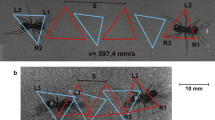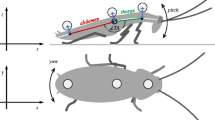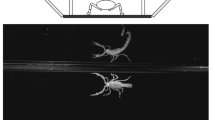Abstract
The gaits of the adult grey mouse lemur Microcebus murinus were studied during treadmill locomotion over a large range of velocities. The locomotion sequences were analysed to determine the gait and the various spatiotemporal gait parameters of the limbs. We found that velocity adjustments are accounted for differently by stride frequency and stride length depending on whether the animal showed a symmetrical or an asymmetrical gait. When using symmetrical gaits the increase in velocity is associated with a constant contribution of the stride length and stride frequency; the increase of the stride frequency being always lower. When using asymmetrical gaits, the increase in velocity is mainly assured by an increase in the stride length which tends to decrease with increasing velocity. A reduction in both stance time and swing time contributed to the increase in stride frequency for both gaits, though with a major contribution from the decrease in stance time. The pattern of locomotion obtained in a normal young adult mouse lemurs can be used as a template for studying locomotor control deficits during aging or in different environments such as arboreal ones which likely modify the kinematics of locomotion.





Similar content being viewed by others
References
Abourachid A, Herbin M, Hackert R, Maes L, Martin V (2007) Experimental study of coordination patterns during unsteady locomotion in mammals. J Exp Biol 210:366–372
Alton F, Baldey L, Caplan S, Morrissey MC (1998) A kinematic comparison of overground and treadmill walking. Clin Biomech 13(6):434–440
Arms A, Voges D, Fischer MS, Preuschoft H (2002) Arboreal locomotion in small new-world monkeys. Z Morphol Anthropol 83:243–263
Bertrand A, Pasquier A, Petiet A, Wiggins C, Kraska A, Joseph-Mathurin N, Aujard F, Mestre-Francés N, Dhenain M (2013) Micro-MRI study of cerebral aging: Ex Vivo Detection of hippocampal subfield reorganization, microhemorrhages and amyloid plaques in mouse lemur primates. Plos One 8(2):e56593. https://doi.org/10.1371/journal.pone.0056593
Biknevicius AR, Reilly SM, McElroy EJ, Bennett MB (2013) Symmetrical gaits and center of mass mechanics in small-bodied, primitive mammals. Zoology 116(1):67–74
Bojados M, Herbin M, Jamon M (2013) Kinematics of treadmill locomotion in mice raised in hypergravity. Behav Brain Res 244:48–57
Bons N, Rieger F, Prudhomme D, Fisher A, Krause K-H (2006) Microcebus murinus: a useful primate model for human cerebral aging and Alzheimer’s disease? Genes Brain Behav 5:120–130
Camargo NF, Sano NY, Ribeiro JF, Vieira EM (2016) Contrasting the realized and fundamental niche of the arboreal walking performance of neotropical rodents. J Mammal 97(1):155–166
Carlson K, Demes B (2010) Gait dynamics of Cebus apella during quadrupedalism on different substrates. Am J Phys Anthropol 142:273–286
Cartmill M, Lemelin P, Schmitt D (2002) Support polygons and symmetrical gaits in mammals. Zool J Linn Soc-Lond 136:401–420
Cartmill M, Lemelin P, Schmitt D (2007a) Primate gaits and primate origins. In: Ravosa M, Dagosto M (eds) Primate Origins: Adaptations and evolution. Springer, New York, pp 403–435
Cartmill M, Lemelin P, Schmitt D (2007b) Understanding the adaptive value of diagonal-sequence gaits in primates: a comment on Shapiro and Raichlen, 2005. Am J Phys Anthropol 133(2):822–825
Clarke KA (1991) Swing time changes contribute to stride time adjustment in the walking rat. Physiol Behav 50:1261–1262
Clarke KA, Still J (1999) Gait analysis in the mouse. Physiol Behav 66:723–729
Crompton RH, Sellers WI, Gunther MM (1993) Energetic efficiency and ecology as selective factors in the saltatory adaptation of prosimian primates. P Roy Soc Lond B Bio 254:41–45
Demes B, Jungers W, Nieschalk U, Stack M, Niemetz C (1990) Size- and speedrelated aspects of quadrupedal walking in slender and slow lorises. In: Jouffroy F (ed) Gravity, posture and locomotion in primates. Il Sedicesimo, Firenze, pp 175–197
Demes B, Larson SG, Stern JT Jr, Jungers WL, Biknevicius AR, Schmitt D (1994) The kinetics of primate quadrupedalism: “hindlimb drive” reconsidered. J Hum Evol 26:353–374
Fischer MS, Lehmann R (1998) Application of cineradiography for the metric and kinematic study of in-phase gaits during locomotion of the pika (Ochotona rufescens, Mammalia: Lagomorpha). Zoology 101:148–173
Fischer MS, Schilling N, Schmidt M, Haarhaus D, Witte H (2002) Basic limb kinematics of small therian mammals. J Exp Biol 205:1315–1338
Grillner S (1981) Control of locomotion in bipeds, tetrapods, and fish. In: Brooks VB (ed). The nervous system, Sect. 1. Bethesda, Maryland: American physiological society. pp 1179–1236
Halbertsma JM (1983) The stride cycle of the cat: the modelling of locomotion by computerized analysis of automatic recordings. Acta Physiol Scand Suppl 521:521–575
Harrell FE (2001) Regression modeling strategies: with applications to linear models, logistic regression, and survival analysis. Springer-Verlag, (ed) New York
Heglund NC, Taylor CR, McMahon TA (1974) Scaling stride frequency and gait to animal size: mice to horse. Science 186:1112–1113
Herbin M, Gasc J-P, Renous S (2004) Symmetrical and asymmetrical gaits in the mouse: patterns to increase velocity. J Comp Physiol A 190:895–906
Herbin M, Gasc J-P, Renous S (2006) How does a mouse increase its velocity? A model for investigation in the control of locomotion. CR Palevol 5:531–540
Herbin M, Hackert R, Gasc J-P, Renous S (2007) Gait parameters of treadmill versus overground locomotion in mouse. Behav Brain Res 181:173–179
Higurashi Y, Hirasaki E, Kumakura H (2009) Gait of japanese macaques (Macaca fuscata) on a horizontal ladder and arboreal stability. Am J Physical Anthropol 138:448–457
Hildebrand M (1965) Symmetrical gaits of horses. Science 150:701–708
Hildebrand M (1967) Symmetrical gaits of primates. Am J Physical Anthropol 26:119–130
Hildebrand M (1977) Analysis of asymmetrical gaits. J Mammal 58:131–156
Hildebrand M (1989) The quadrupedal gaits of vertebrates. Bioscience 39:766–775
Karantanis N-E, Youlatos D, Rychlik L (2015) Diagonal gaits in the feathertail glider Acrobates pygmaeus (Acrobatidae, Diprotodontia): insights for the evolution of primate quadrupedalism. J Human Evol 86(Suppl C):43–54
Karantanis N-E, Rychlik L, Herrel A, Youlatos D (2017a) Arboreal locomotion in eurasian harvest mice Micromys Minutus (Rodentia: Muridae): the gaits of small mammals. J Exp Zool Part A 327(1):38–52
Karantanis N-E, Rychlik L, Herrel A, Youlatos D (2017b) Arboreal gaits in three sympatric rodents Apodemus agrarius, Apodemus flavicollis (Rodentia, Muridae) and Myodes glareolus (Rodentia, Cricetidae). Mamm Biol 83(Suppl C):51–63
Lammers AR, Zurcher U (2011) Torque around the center of mass: dynamic stability during quadrupedal arboreal locomotion in the Siberian chipmunk (Tamias sibiricus). Zoology 114:95–103
Languille S, Blanc S, Blin O, Canale CI, Dal-Pan A, Devau G, Dhenain M, Dorieux O, Epelbaum J, Gomez D, Hardy I, Henry PY, Irving EA, Marchal J, Mestre-Francés N, Perret M, Picq JL, Pifferi F, Rahman A, Schenker E, Terrien J, Théry M, Verdier JM, Aujard F (2012) The grey mouse lemur: a non-human primate model for ageing studies. Ageing Res Rev 11(1):150–62
Languille S, Liévin-Bazin A, Picq J-L, Louis C, Dix S, de Barry J, Blin O, Richardson J, Bordet R, Schenker E, Djelti F, Aujard F (2015) Deficits of psychomotor and mnesic functions across aging in mouse lemur primates. Front Behav Neurosci 8:446
Larson SG, Schmitt D, Lemelin P, Hamrick M (2000) Uniqueness of primate forelimb posture during quadrupedal locomotion. Am J Phys Anthropol 112(1):87–101
Larson SG, Schmitt D, Lemelin P, Hamrick M (2001) Limb excursion during quadrupedal walking: how do primates compare to other mammals? J Zool 255(3):353–365
Lemelin P, Cartmill M (2010) The effect of substrate size on the locomotion and gait patterns of the kinkajou (Potos flavus). J Exp Zool Part A 313(3):157–168
Lemelin P, Schmitt D, Cartmill M (2003) Footfall patterns and interlimb co-ordination in opossums (Family Didelphidae): evidence for the evolution of diagonal-sequence walking gaits in primates. J Zool 260(4):423–429
Lin S-I, Woollacott MH (2002) Postural muscle responses following changing balance threats in young, stable older, and unstable older adults. J Motor Behav 34(1):37–44
Martin RD (1972) A laboratory breeding colony of the lesser mouse lemur. In: Karger (ed) Breeding primates, Basel, pp 161–171
Motulsky HJ, Brown RE (2006) Detecting outliers when fitting data with nonlinear regression a new method based on robust nonlinear regression and the false discovery rate. BioMed Central Ltd. L2 - http://www.biomedcentral.com/1471-2105/7/123
Némoz-Bertholet F, Aujard F (2003) Physical activity and balance performance as a function of age in a prosimian primate (Microcebus murinus). Exp Gerontol 38:407–414
Nyakatura JA, Heymann EW (2010) Effects of support size and orientation on symmetric gaits in free-ranging tamarins of Amazonian Peru: implications for the functional significance of primate gait sequence patterns. J Human Evol 58(3):242–251
Nyakatura JA, Fischer MS, Schmidt M (2008) Gait parameter adjustments of cotton-top tamarins (Saguinus oedipus, Callitrichidae) to locomotion on inclined arboreal substrates. Am J Physical Anthropol 135:13–26
Perret M (1997) Change in photoperiodic cycle affects life span in a prosimian primate (Microcebus murinus). J Biol Rhythms 12(2):136–145
Pridmore P (1994) Locomotion in Dromiciops australis (Marsupialia. Microbiotheriidae). Aust J Zool 42:679–699
Reilly SM, Biknevicius AR (2003) Integrating kinetic and kinematic approaches to the analysis of terrestrial locomotion. In: Bels VL, Gasc J-P, Casinos A (eds) Vertebrate biomechanics and evolution. BIOS Scientific Publishers Ltd, Oxford, pp 243–265
Schilling N, Fischer MS (1999) Kinematic analysis of treadmill locomotion of tree shrews, Tupaia glis (Scandentia: Tupaiidae). Z Saugetierkd 64:129–133
Schmidt M (2008) Forelimb proportions and kinematics: how are small primates different from other small mammals? J Exp Biol 211:3775–3789
Schmitt D (2003) Evolutionary implications of the unusual walking mechanics of the common marmoset (C. jacchus). Am J Physical Anthropol 122:28–37
Schmitt D, Lemelin P (2002) Origins of primate locomotion: gait mechanics of the woolly opossum. Am J Phys Anthropol 118(3):231–238
Schmitt D, Cartmill M, Griffin TM, Hanna JB, Lemelin P (2006) Adaptive value of ambling gaits in primates and other mammals. J Exp Biol 209:2042–2049
Serradj N, Jamon M (2007) Age-related changes in the motricity of the inbred mice strains 129/sv and C57BL/6j. Behav Brain Res 177:80–89
Shapiro LJ, Young JW (2010) Is primate-like quadrupedalism necessary for fine-branch locomotion? A test using sugar gliders (Petaurus breviceps). J Human Evol 58(4):309–319
Shapiro LJ, Young JW, Souther A (2011) Quadrupedal locomotion of Saimiri boliviensis: a comparison of field and laboratory-based kinematic data. In: D’Aoùt K, Vereecke EE (eds) Primate locomotion: linking field and laboratory research. Springer New York, New York, NY, pp 335–356
Shapiro LJ, Young JW, VandeBerg JL (2014) Body size and the small branch niche: Using marsupial ontogeny to model primate locomotor evolution. J Human Evol 68::14–31
Shapiro LJ, Kemp AD, Young JW (2016) Effects of substrate size and orientation on quadrupedal gait kinematics in mouse lemurs (Microcebus murinus). J Exp Zool Part A 325:329–343
Stevens NJ (2006) Stability, limb coordination and substrate type: the ecorelevance of gait sequence pattern in primates. J Exp Zool Part A 305A(11):953–963
Stevens NJ (2008) The effect of branch diameter on primate gait sequence pattern. Am J Primatol 70:356–362
Stolze H, Kuhtz-Buschbeck JP, Mondwurf C, Boczek-Funcke A, Johnk K, Deuschl G, Illert M (1997) Gait analysis during treadmill and overground locomotion in children and adults. Electroen Clin Neuro 105(6):490–497
Sukhanov VB (1974) General system of symmetrical locomotion of terrestrial vertebrates and some features of movement of lower tetrapods. Washington, D. C.
Thomas P, Pouydebat E, Hardy I, Aujard F, Ross CF, Herrel A (2015) Sexual dimorphism in bite force in the grey mouse lemur. J Zool 296(2):133–138
Vilensky JA, Patrick MC (1985) Gait characteristics of two squirrel monkeys, with emphasis on relationships with speed and neural control. Am J Phys Anthropol 68:429–444
Wallace IJ, Demes B (2008) Symmetrical gaits of Cebus apella: implications for the functional significance of diagonal sequence gait in primates. J Human Evol 54(6):783–794
Wooley CM, Xing S, Burgess RW, Cox GA, Seburn KL (2009) Age, experience and genetic background influence treadmill walking in mice. Physiol Behav 96:350–361
Young JW (2009) Substrate determines asymmetrical gait dynamics in marmosets (Callithrix jacchus) and Squirrel monkeys (Saimiri boliviensis). Am J Phys Anthropol 138:403–420
Young JW (2012) Gait selection and the ontogeny of quadrupedal walking in squirrel monkeys (Saimiri boliviensis). Am J Physical Anthropol 147:580–592
Zug GR (1972) A critique of the walk pattern analysis of symmetrical quadrupedal gaits. Anim Behav 20:436–438
Zumwalt AC, Hamrick M, Schmitt D (2006) Force plate for measuring the ground reaction forces in small animal locomotion. J Biomech 39:2877–2881
Acknowledgements
We are indebted to D. Champeval, L. Dezaire, E. Guéton-Estrade, S. Gondor, and D. Lavoine who provided attentive care for the animals. We are very grateful to both reviewers for their carefully comments which largely increase the quality of our manuscript, and A. Herrel for improving the English. Funded by ANR Locomo (ANR-06-BLAN-0132). The procedures used in this study were approved by the Ethics committee on animal experimentation “Comité Cuvier” registration number 68-023.
Funding
This work was performed with the financial support from ANR Locomo (06-BLAN-0132) and the UMR 7179 (MNHN/CNRS).
Author information
Authors and Affiliations
Corresponding author
Rights and permissions
About this article
Cite this article
Herbin, M., Hommet, E., Hanotin-Dossot, V. et al. Treadmill locomotion of the mouse lemur (Microcebus murinus); kinematic parameters during symmetrical and asymmetrical gaits. J Comp Physiol A 204, 537–547 (2018). https://doi.org/10.1007/s00359-018-1256-2
Received:
Revised:
Accepted:
Published:
Issue Date:
DOI: https://doi.org/10.1007/s00359-018-1256-2




